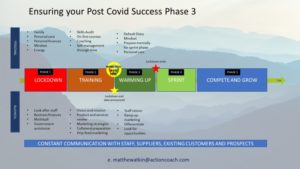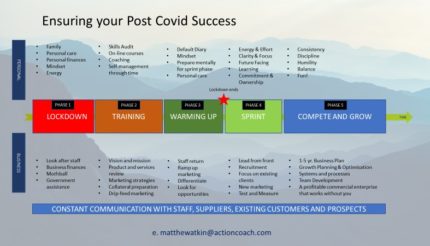This is the third in a series of 5 articles I am writing to expand on the preparations for and then the unwinding of the lockdown as illustrated below.

We have reached the point of the staged reduction of lock-down constraints, introduced by the Prime Minister. It is designed to enable the return to a safe working environment of as many people as possible. The economic consequences of the lock-down are already massive, so to persist without variation would have been as irresponsible as ignoring the spiraling infection and death rate would have been in March.
The scale of the National deficit is already huge and growing daily. It is forecast to top £2 trillion, or 100% of GDP, even before the full extent of the Government rescue packages are factored in. This is equivalent to £65,000 for every person of working age in the UK. In WW2 we accumulated a deficit of 250% of GDP. It took until 1954 for rationing to be abandoned and until 2014 to repay all our wartime debts.
Where the risks are reasonable, we must get back to work; not only for our own sanity, but also for the economic future of our children and, possibly, theirs too. We should acknowledge that there will be risk associated with anything approaching a normal life until there is a vaccine that works and lasts.
So what do we need to do to prepare for this return?
Your Business.
Staff return:
The rules that you will apply within the business are likely to have to remain in place until at least next year. They will have to be drafted to comply with legislation as well as being practical and relevant to your specific workplace. When their application begins to fray at the edges with prolonged use, will they be rendered useless, or will they still confer the same safe workplace? What equipment is available to use right now and what looks like coming onto the market soon? I have seen some wonderfully innovative designs for working equipment that will protect the wearer whilst enabling them to work for prolonged periods, both physically and at a desk.
Marketing:
It is often said that the first sign of a recession is reduced spending on advertising and other marketing. Advertising has never been cheaper in real terms than it is now, nor have there been as few takers for the slots. As Martin Sorrell put it, this is a period of extreme evolutionary selection pressure on marketing agencies and there will be multiple casualties. To develop your brand, retain your market share, win what little business there may be out there or break in to new markets with your new innovative or alternative product, you will have to spend time effort and, very probably, money on marketing.
Identify your target (with great care and understanding), identify how best to reach them, build your marketing plan, allocate appropriate resources to it and then Test and Measure your results. The truth is that most marketing activity bombs; test your strategies by their Return on Investment until you find those that work. When you know what works, ramp it up to the point of optimum return.
Differentiate:
As Henry Ford said, “If it doesn’t add value, it’s waste”. Difference for its own sake is a waste of effort. It must be of value to your customer. There are likely to be lots of people chasing the same customers, so what will differentiate your service or product from the competition? What benefit will your product or service bring to the customer that no-one or very few can match? If you can’t answer that, you’re in for a hard time.
Look for Opportunities:
These could be either internal or external. What are the weaknesses within your existing business and can they be reinforced given the changed circumstances we’re in? Have you got the right people in the right seats, what systems could be enhanced, are you and your team as productive as you could be, is your IT up to the new world order?
Externally, are there opportunities to exploit that you either ignored in the past or have newly arisen? Could you acquire an existing business that offers genuine synergistic benefits or is there a new product or service you could offer. In Chinese, two symbols represent the word Risk – one for danger and the other for opportunity. We have generally recognized the danger, but have we looked for the opportunity that sits alongside it?
You and your People.
Mindset:
Positivity and Optimism sit at the heart of leadership in a crisis, for who gives of their best to someone with a face like thunder and an air of defeat about them? Not blind optimism, but optimism born of a review of the brutal facts of the situation and a recognition that vision, hard work, grit and determination will prevail, regardless of how difficult the situation currently looks. Take care to communicate your well-founded optimism and your vision of the future, so that your team become aligned to it and engage with you, the business and each other.
Preparation:
No one likes being surprised with a sudden, unexpected change of situation or demand. Prepare your team for their impending return, so that they feel warned, ready and willing to return and contribute. Be prepared to answer their safety concerns too, over spacing, PPE, shift patterns, childcare demands and the multiplicity of specifics that apply to them.
Default Diary:
As you look forward to the work pattern that will be applied to both yourself and your team it is as well to plan your diary to maximize your personal productivity and enable others throughout the business to do the same. Given the limitations that spacing and split shifts might impose, how can the effective use of time be maximized? The default diary is there to ensure blocks of time are given first to the most important things that must be done. Finding the very few things that each person must do well and giving them just sufficient time to do them, is critical to ensure success.
Personal Care:
Finally, you and your people are not machines; you need to take care of yourself and your family to ensure that you’re in a fit condition, both mentally and physically, to do your best work. Give yourself and them the time to repair and rejuvenate following periods of intensive work or stress.
To discuss anything I’ve said in any of these articles, use the contact button below and we’ll arrange a call.
CONTACT ME



